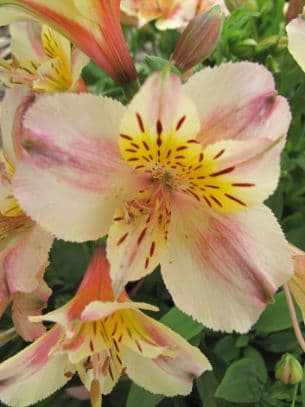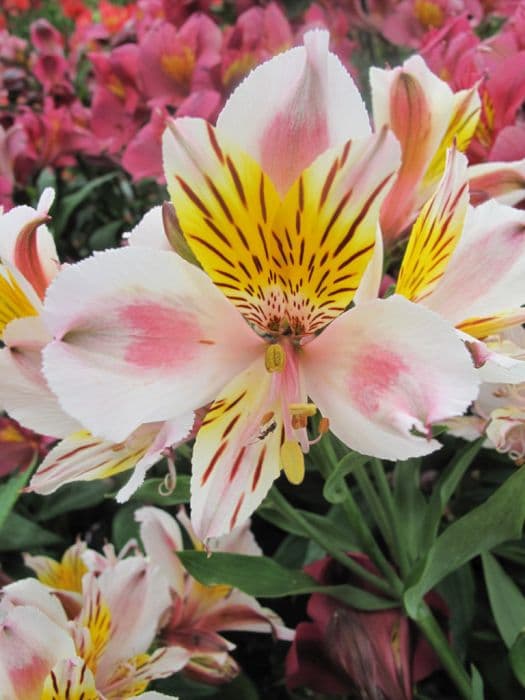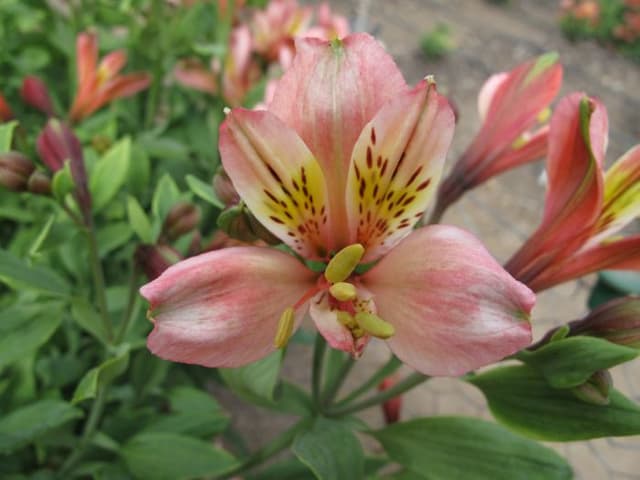Peruvian Lily Alstroemeria 'Coronet'

ABOUT
Alstroemeria 'Coronet', commonly known as the Peruvian lily or lily of the Incas, is a strikingly beautiful plant that captivates attention with its unique and colorful blooms. The flowers of this variety typically exhibit an array of colors with a distinctive mix of creamy-white, flushed with soft pink to deep rose. Each blossom appears with intricate, streaked patterns of darker tones, often with dashes or spots that enhance their appeal. The petals are typically characterized by a slightly ruffled, curved look, which adds to their distinctive charm. Leaves of Coronet are narrow, lance-shaped, and can often twist slightly, which creates an interesting visual texture to the foliage that is a lush, deep green, providing a lovely contrasting backdrop to the vivid flowers. The foliage gracefully grows outwards and upwards, adding to the plant's bushy and lush appearance. One of the most notable characteristics of the Peruvian lily 'Coronet' is the longevity of its blooms, both in the garden and when cut for arrangements. This aspect, combined with the plant's vibrant colors and attractive patterns, makes it a popular choice for florists and garden enthusiasts alike. Flowering typically occurs during the warmer months, and when in full bloom, the plant is a stunning display of color and form. The overall presentation of Alstroemeria 'Coronet' is one of elegance and exotic charm, which is why it is cherished in gardens and floral displays worldwide.
About this plant
 Names
NamesFamily
Alstroemeriaceae
Synonyms
Peruvian Lily, Lily of the Incas, Parrot Lily
Common names
Alstroemeria 'Coronet'.
 Toxicity
ToxicityTo humans
The Peruvian Lily (Alstroemeria 'Coronet') has a low level of toxicity to humans. If ingested, the plant may cause mild gastrointestinal symptoms such as nausea, vomiting, or diarrhea. Handling the Peruvian Lily can sometimes result in skin irritation or dermatitis due to the presence of tuliposide A, a skin irritant found in the plant. It is advisable to wear gloves when handling this plant to avoid potential skin reactions.
To pets
The Peruvian Lily is mildly toxic to pets, such as cats and dogs. If ingested, it can cause gastrointestinal upset, characterized by symptoms like vomiting or diarrhea. Unlike some other lilies, which are highly toxic to cats and can cause kidney failure, the Peruvian Lily does not have the same level of toxicity. Nevertheless, it is still recommended to keep this plant out of reach of pets to prevent any discomfort or illness associated with ingestion.
 Characteristics
CharacteristicsLife cycle
Perennials
Foliage type
Semi-deciduous
Color of leaves
Green
Flower color
Mixed
Height
2-3 feet (0.6-0.9 meters)
Spread
1-2 feet (0.3-0.6 meters)
Plant type
Bulb
Hardiness zones
7
Native area
South America
Benefits
 General Benefits
General Benefits- Long-lasting blooms: Alstroemeria 'Coronet' is known for its flowers that can last for several weeks, both in the garden and as cut flowers in a vase.
- Vibrant colors: The 'Coronet' variety offers striking colors that can enhance the visual appeal of any garden or floral arrangement.
- Attracts pollinators: It can attract bees, butterflies, and other beneficial pollinators to the garden, promoting biodiversity.
- Low maintenance: This plant is relatively easy to care for, requiring minimal upkeep once established.
- Drought tolerance: Alstroemeria 'Coronet' can tolerate periods of low water, making it suitable for drier climates and water-wise gardens.
- Versatile planting options: It can be planted in beds, borders, and containers, providing flexibility in garden design and space utilization.
- Seasonal interest: With its extended blooming period, it contributes to the garden's interest throughout the growing season.
 Medical Properties
Medical PropertiesThis plant is not used for medical purposes.
 Air-purifying Qualities
Air-purifying QualitiesThis plant is not specifically known for air purifying qualities.
 Other Uses
Other Uses- Photography Prop: The Alstroemeria 'Coronet', often known as Peruvian Lily, is frequently used as a vibrant subject in macro and botanical photography due to its intricate patterns and striking colors.
- Edible Garnish: Although not widely known, the flowers of the Peruvian Lily can be used as an edible garnish for desserts and salads, providing an exotic and colorful touch to dishes.
- Artistic Inspiration: Artists may use the Peruvian Lily's unique form and color as inspiration for paintings, drawings, and textile designs.
- Eco-friendly Confetti: Dried petals of the Peruvian Lily can be used as biodegradable confetti for celebrations, reducing the environmental impact compared to plastic confetti.
- Color Dyes: The pigments in the petals of the Peruvian Lily can be used to create natural dyes for fabrics or crafts.
- Floral Crafts: The sturdy stems and long-lasting blooms of the Peruvian Lily make them ideal for creating floral crowns, wreaths, and other craft items.
- Journaling and Scrapbooking: Pressed flowers and leaves of the Peruvian Lily can be incorporated into scrapbooking and journaling for decorative purposes.
- Learning Tool: The Peruvian Lily can be used in educational settings to teach students about botany, plant reproduction, and hybridization techniques.
- Aromatherapy: While not a typical use, the subtle scent of Peruvian Lily flowers may be used in creating a calming atmosphere for aromatherapy sessions.
- Feng Shui: In some cultures, the Peruvian Lily may be used in Feng Shui practices to bring positive energy and prosperity into the home due to their vibrant and happy appearance.
Interesting Facts
 Feng Shui
Feng ShuiThe Peruvian Lily is not used in Feng Shui practice.
 Zodiac Sign Compitability
Zodiac Sign CompitabilityThe Peruvian Lily is not used in astrology practice.
 Plant Symbolism
Plant Symbolism- Friendship: Alstroemeria, commonly known as the Peruvian lily or lily of the Incas, often symbolizes the bonds of friendship due to its intricate and intertwined leaves which represent the intertwined lives of friends.
- Devotion: The Peruvian lily is also a symbol of devotion and mutual support among friends or partners, making it an appropriate gift to show commitment.
- Wealth and Prosperity: The multiple leaves and vibrant blooms of the Peruvian lily can signify abundance and wealth.
- Achievement: The complex bloom structure and longevity of flowers make it a token for the achievements and hard work, as it can indicate growth and persistence.
- Fortune: Seen as a good luck token, the Peruvian lily can be gifted to wish someone luck with new ventures or undertakings.
 Water
WaterThe Peruvian Lily should be watered regularly to keep the soil consistently moist but not soggy. During the growing season, you may need to water once every week, providing about one to two gallons per watering, depending on the size of the plant and environmental conditions. Reduce the frequency to every two weeks during the dormant period in the winter. If the top inch of soil feels dry, it's time to water again. Over-watering can lead to root rot, so drainage is crucial.
 Light
LightPeruvian Lilies thrive in full sun to partial shade conditions. They perform best when they receive at least six hours of sunlight daily but are protected from the harsh afternoon sun, especially in hotter climates. An east or west-facing spot that gets dappled sunlight is often ideal for these plants.
 Temperature
TemperaturePeruvian Lilies can tolerate a wide range of temperatures but grow best when the daytime temperatures are between 65 and 80 degrees Fahrenheit. They can survive minimum temperatures down to about 23 degrees Fahrenheit but should be protected from frost. Optimal growth occurs when night temperatures are slightly cooler, around 40 to 50 degrees Fahrenheit.
 Pruning
PruningPeruvian Lilies benefit from pruning to remove spent blooms and encourage new growth. Deadheading regularly throughout the blooming season can prolong the flowering period. After the first killing frost in the fall, cut back the foliage to ground level. This yearly pruning prepares the plant for winter and promotes healthier growth in the spring.
 Cleaning
CleaningAs needed
 Soil
SoilThe best soil mix for the Peruvian Lily (Alstroemeria 'Coronet') is a well-draining, fertile loam with good organic content. It should be slightly acidic to neutral, with a pH range of 6.0 to 7.0. Amend with compost or peat moss to increase fertility and maintain proper moisture levels.
 Repotting
RepottingPeruvian Lilies do not typically require frequent repotting; it's often best to repot them every 2 to 3 years. Overhandling can cause stress to the plant, so it's important to do so only when necessary, such as when the plant outgrows its current container.
 Humidity & Misting
Humidity & MistingPeruvian Lilies thrive in moderate humidity levels. They prefer environments that imitate their native habitats, so aim for about 40-60% humidity for optimal growth. Avoid excessively dry air which can lead to leaf problems.
 Suitable locations
Suitable locationsIndoor
Provide bright, indirect light and keep in cool room.
Outdoor
Place in partial shade, protect from harsh elements.
Hardiness zone
7-10 USDA
 Life cycle
Life cycleThe life of the Alstroemeria 'Coronet', commonly known as the Peruvian Lily, begins with seed germination, which occurs in a moist, well-drained soil with a warm temperature after the risk of frost has passed. Following germination, the plant goes through a stage of vegetative growth where elongated, lance-shaped leaves and sturdy stems develop, usually taking a few weeks to establish. Flowering occurs during the summer months, showcasing the plant's distinctive trumpet-shaped flowers with streaked or spotted petals in a variety of colors. After pollination, the flowers give way to dry capsules containing seeds, completing the plant's reproductive cycle. In some regions, the Peruvian Lily behaves as a perennial, with its tuberous roots surviving through winter and regrowing in spring. When not grown from seed, the plant can also be propagated by dividing these tubers which can further spread and increase the clump size over years, effectively renewing the plant's life cycle.
 Propogation
PropogationPropogation time
Spring to early summer
Alstroemeria 'Coronet', commonly known as Peruvian Lily or Lily of the Incas, is typically propagated by division, which is the most popular method for this plant. This should be done in the early spring or late fall. To propagate by division, you'll need to carefully dig up the tuberous rhizomes and gently separate them, ensuring that each division has at least one growth tip or eye. Replant the divisions at the same depth they were growing at previously, which is usually about 6 to 8 inches (15 to 20 centimeters) deep, and water them well. Divisions allow for Alstroemeria 'Coronet' to establish more rapidly than seed propagation, ensuring that the offspring plants are true to the parent's characteristics.

![Peruvian lily [Princess Carmina]](/_next/image?url=https%3A%2F%2Fplants-admin.emdemapps.com%2Fimages%2Fplants%2F%2Fimages%2F604b5b436505f.png&w=640&q=75)



![Peruvian lily [Inca Glow]](/_next/image?url=https%3A%2F%2Fplants-admin.emdemapps.com%2Fimages%2Fplants%2F%2Fimages%2F604b5e99e48d9.png&w=640&q=75)
![Peruvian lily [Inca Smile]](/_next/image?url=https%3A%2F%2Fplants-admin.emdemapps.com%2Fimages%2Fplants%2F%2Fimages%2F604b5cad8fa91.png&w=640&q=75)
![Peruvian lily [Inticancha Passion]](/_next/image?url=https%3A%2F%2Fplants-admin.emdemapps.com%2Fimages%2Fplants%2F%2Fimages%2F604b5f7a78c8d.png&w=640&q=75)

